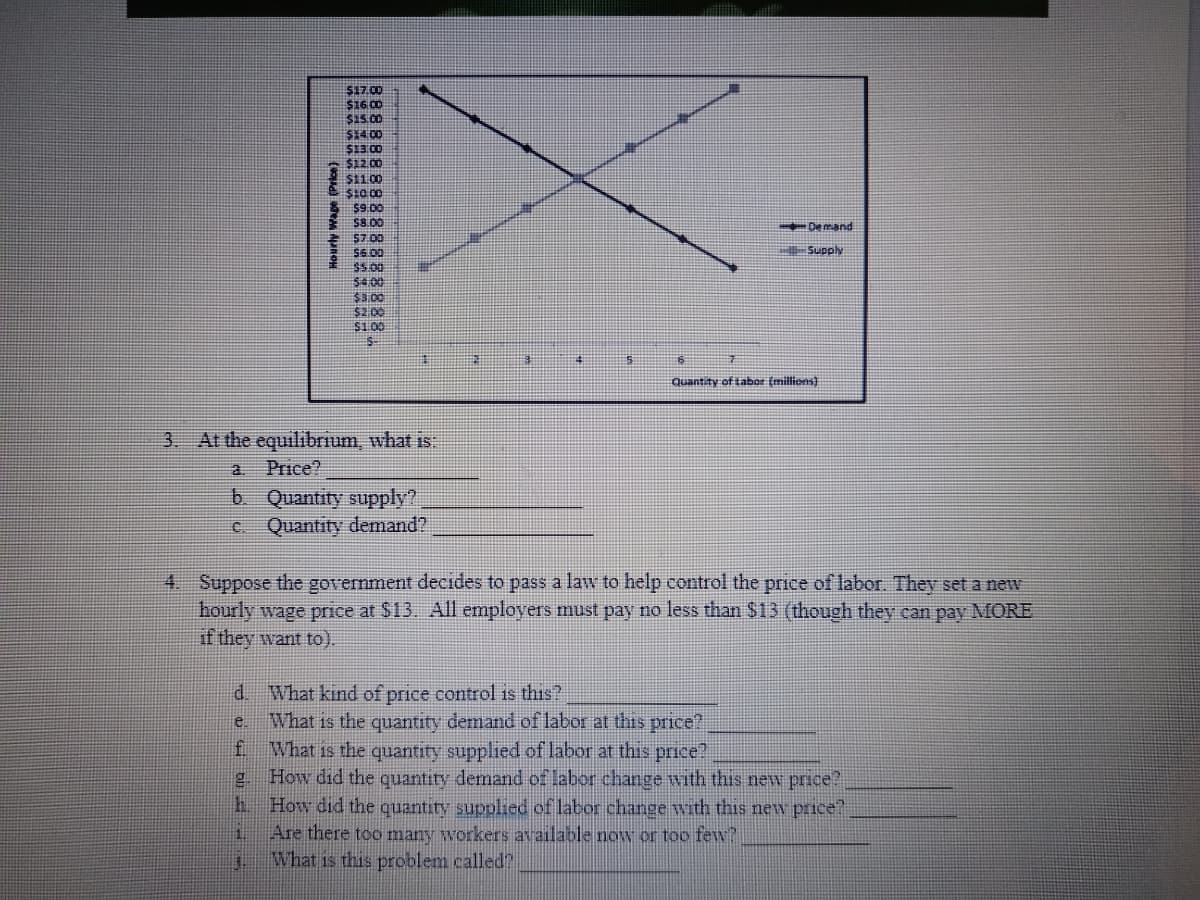$17.00 $16.00 $15.00 $14 00 $13.00 $12.00 $11.00 $10.00 $9.00 $8.00 Demand 57 00 S6.00 $5.00 5400 $3.00 $2.00 $100 Supply Quantity of tabor (millions) At the equilibrium, what is a. Price? b Quantity supply? C Quantity demand? b. C. Suppose the government decides to pass a law to help control the price of labor. They set a new hourly wage price at $13. All employers must pay no less than $13 (though they can pay MORE if they want to). What kind of price control is this? What is the quantity demand of labor at this price? What is the quantity supplied of labor at this price? d. e. f. (oua) em Aanon
$17.00 $16.00 $15.00 $14 00 $13.00 $12.00 $11.00 $10.00 $9.00 $8.00 Demand 57 00 S6.00 $5.00 5400 $3.00 $2.00 $100 Supply Quantity of tabor (millions) At the equilibrium, what is a. Price? b Quantity supply? C Quantity demand? b. C. Suppose the government decides to pass a law to help control the price of labor. They set a new hourly wage price at $13. All employers must pay no less than $13 (though they can pay MORE if they want to). What kind of price control is this? What is the quantity demand of labor at this price? What is the quantity supplied of labor at this price? d. e. f. (oua) em Aanon
Essentials of Economics (MindTap Course List)
8th Edition
ISBN:9781337091992
Author:N. Gregory Mankiw
Publisher:N. Gregory Mankiw
Chapter6: Supply, Demand And Government Policies
Section: Chapter Questions
Problem 10PA
Related questions
Question
I need help 4, d to f

Transcribed Image Text:$17.00
$16 0
$15.00
$14 00
$13.00
$12.00
$11.00
$ $9.00
* S8.00
57 00
56.00
s5.00
$4.00
$3.00
$2 00
$100
De mand
Supply
Quantity of tabor (millions)
3 At the equilibrium, what is:
a.
Price?
b Quantity supply?
Quantity demand?
C.
4. Suppose the government decides to pass a law to help control the price of labor. They set a new
hourly wage price at $13. All employers must pay no less than $13 (though they can pay MORE
if they want to).
d. What kind of price control is this?
e What is the quantity demand of labor at this priice
f What is the quantity supplied of labor at this price?
e How did the quantity demand of labor change with this new price?,
E How did the quantity supplied of labor change with this new price?
1.
Are there too many workers available now or too tew?
What is this problem called?
Expert Solution
This question has been solved!
Explore an expertly crafted, step-by-step solution for a thorough understanding of key concepts.
This is a popular solution!
Trending now
This is a popular solution!
Step by step
Solved in 3 steps

Follow-up Questions
Read through expert solutions to related follow-up questions below.
Recommended textbooks for you

Essentials of Economics (MindTap Course List)
Economics
ISBN:
9781337091992
Author:
N. Gregory Mankiw
Publisher:
Cengage Learning

Principles of Economics (MindTap Course List)
Economics
ISBN:
9781305585126
Author:
N. Gregory Mankiw
Publisher:
Cengage Learning

Principles of Microeconomics (MindTap Course List)
Economics
ISBN:
9781305971493
Author:
N. Gregory Mankiw
Publisher:
Cengage Learning

Essentials of Economics (MindTap Course List)
Economics
ISBN:
9781337091992
Author:
N. Gregory Mankiw
Publisher:
Cengage Learning

Principles of Economics (MindTap Course List)
Economics
ISBN:
9781305585126
Author:
N. Gregory Mankiw
Publisher:
Cengage Learning

Principles of Microeconomics (MindTap Course List)
Economics
ISBN:
9781305971493
Author:
N. Gregory Mankiw
Publisher:
Cengage Learning

Principles of Macroeconomics (MindTap Course List)
Economics
ISBN:
9781305971509
Author:
N. Gregory Mankiw
Publisher:
Cengage Learning

Principles of Microeconomics
Economics
ISBN:
9781305156050
Author:
N. Gregory Mankiw
Publisher:
Cengage Learning

Principles of Macroeconomics (MindTap Course List)
Economics
ISBN:
9781285165912
Author:
N. Gregory Mankiw
Publisher:
Cengage Learning